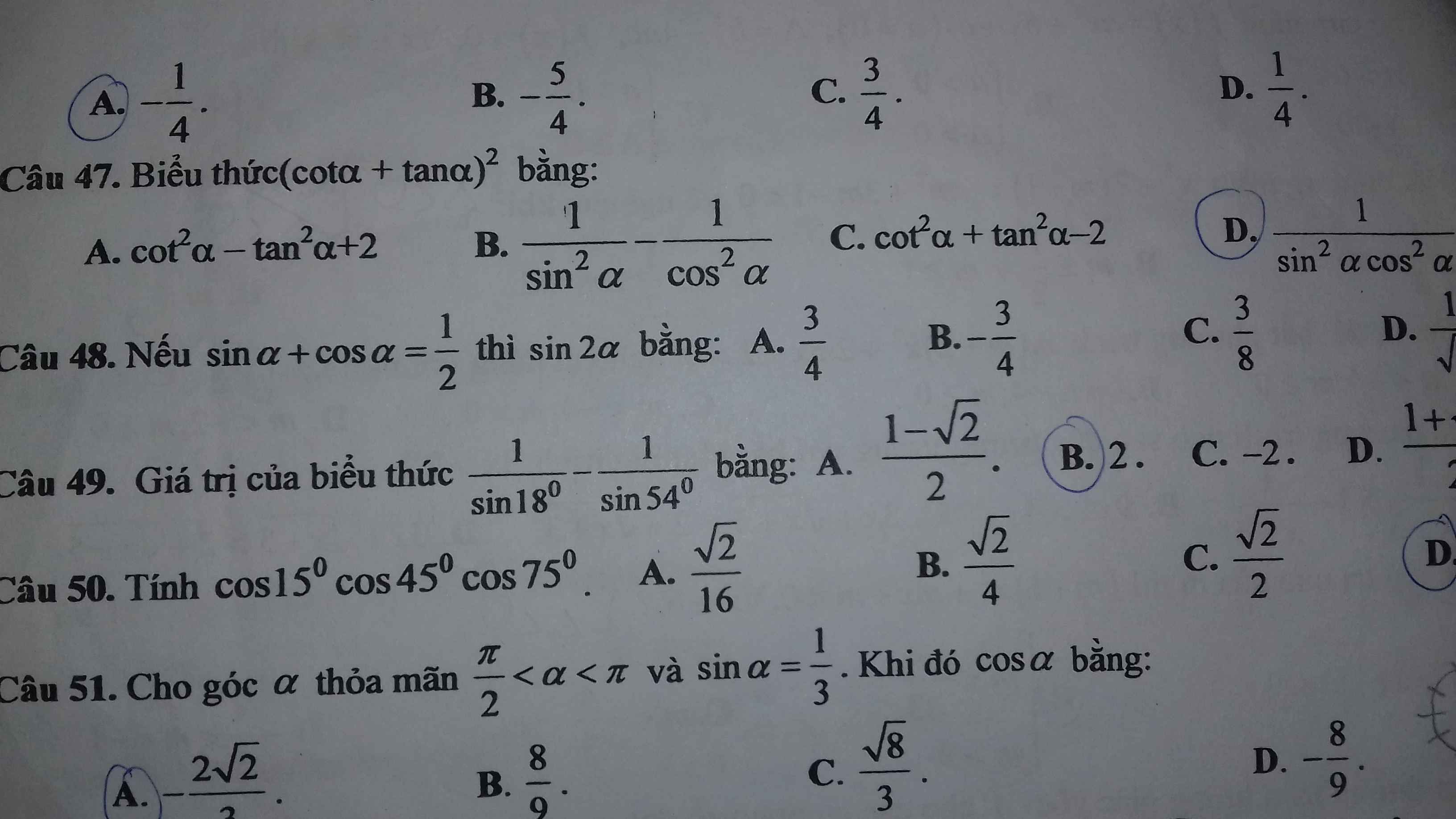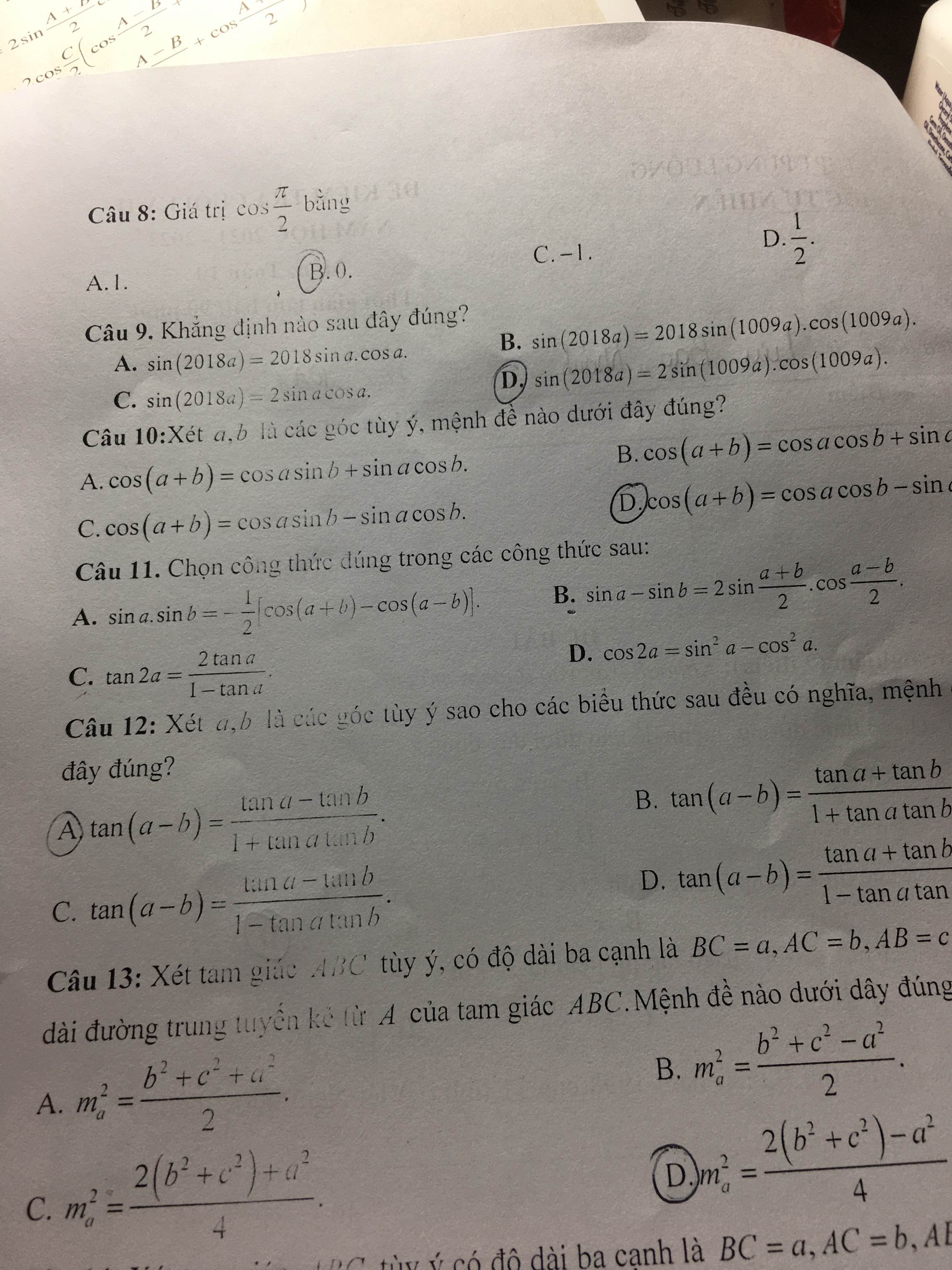
Hãy nhập câu hỏi của bạn vào đây, nếu là tài khoản VIP, bạn sẽ được ưu tiên trả lời.


47.
\(\left(cot\alpha+tan\alpha\right)^2=\left(\dfrac{cos\alpha}{sin\alpha}+\dfrac{sin\alpha}{cos\alpha}\right)^2=\left(\dfrac{cos^2\alpha+sin^2\alpha}{sin\alpha.cos\alpha}\right)^2=\dfrac{1}{sin^2\alpha.cos^2\alpha}\)
(cota +tana)\(^2\)=cot\(^2\)a+2cota.tana+tan\(^2\)a=(cot\(^2\)a +1)+(tan\(^2\)+1)=\(\dfrac{1}{sin^2a}\)+\(\dfrac{1}{cos^2a}\)=\(\dfrac{cos^2a+sin^2a}{cos^2a.sin^2a}\)=\(\dfrac{1}{cos^2a.sin^2a}\)

8.
\(0< a< \dfrac{\pi}{2}\Rightarrow cosa>0\Rightarrow cosa=\sqrt{1-sin^2a}=\dfrac{2\sqrt{2}}{3}\)
\(cosa-sina=\dfrac{2\sqrt{2}}{3}-\dfrac{1}{3}=\dfrac{-1+2\sqrt{2}}{3}\)
9.
Có 2 điểm (ứng với \(k=0\) và \(k=1\))
10.
\(2-x\ge0\Leftrightarrow x\le2\)
\(\Rightarrow S=(-\infty;2]\)
11.
Phương trình AB theo đoạn chắn: \(\dfrac{x}{3}+\dfrac{y}{-4}=1\Leftrightarrow\dfrac{x}{3}-\dfrac{y}{4}=1\)

Câu 93
Ta có \(AC^2=AB^2+BC^2-2.AB.BC.cosB=19\Rightarrow AC=\sqrt{19}\)
chọn D

\(5\overrightarrow{v}=3\overrightarrow{b}-2\overrightarrow{a}\Rightarrow\overrightarrow{v}=\dfrac{3}{5}\overrightarrow{b}-\dfrac{2}{5}\overrightarrow{a}=\dfrac{3}{5}\left(-1;2\right)-\dfrac{2}{5}\left(3;-4\right)=\left(-\dfrac{9}{5};\dfrac{14}{5}\right)\)

\(sina.sinb=-\dfrac{1}{2}\left[cos\left(a+b\right)-cos\left(a-b\right)\right]\) là công thức đúng

Lời giải:
a. TXĐ: $\mathbb{R}$
Với $x\in\mathbb{R}$ thì $-x\in\mathbb{R}$
$f(x)=|x|=|-x|=f(-x)$
$\Rightarrow $ hàm chẵn
b. TXĐ: $\mathbb{R}$
Với $1\in\mathbb{R}$ thì $-1\in\mathbb{R}$
$f(1)=9; -f(1)=-9; f(-1)=1$
$\Rightarrow f(1)\neq f(-1); -f(1)\neq f(-1)$ nên hàm không chẵn không lẻ.
c.
TXĐ: $\mathbb{R}$
Với $x\in\mathbb{R}$ thì $-x\in\mathbb{R}$
$f(-x)=(-x)^3+(-x)=-(x^3+x)=-f(x)$ nên hàm lẻ
d.
TXĐ: $\mathbb{R}$
Với $1\in\mathbb{R}$ thì $-1\in\mathbb{R}$
$f(1)=3; f(-1)=1$
$\Rightarrow f(1)\neq f(-1); -f(1)\neq f(-1)$
Do đó hàm không chẵn không lẻ.

11.
\(BPT\Leftrightarrow\left\{{}\begin{matrix}3-x>0\\\left|1-x\right|>x-1\end{matrix}\right.\)
\(\Leftrightarrow\left\{{}\begin{matrix}x< 3\\\left|x-1\right|>x-1\end{matrix}\right.\)
\(\Leftrightarrow\left\{{}\begin{matrix}x< 3\\x-1< 0\end{matrix}\right.\) \(\Leftrightarrow x< 1\)
Đáp án A
12.
Đường thằng d nhận (1;2) là 1 vtpt nên đường thẳng vuông góc d nhận (2;-1) là 1 vtpt
\(\Rightarrow\) Loại A, C
Với đáp án B, đường thẳng cắt 2 trục tại \(A\left(0;-1\right)\) và \(B\left(\dfrac{1}{2};0\right)\)
\(S_{OAB}=\dfrac{1}{2}.1.\left(\dfrac{1}{2}\right)=\dfrac{1}{4}\ne1\) (ktm)
Vậy D là đáp án đúng










Câu 11:
Gọi pt là y=ax+b
=> 3a+b=-7; a+b=-7
<=>a=0; b=-7
=> y=-7 -> (b)
Câu 11 đáp án là D chứ bạn, sao lại B